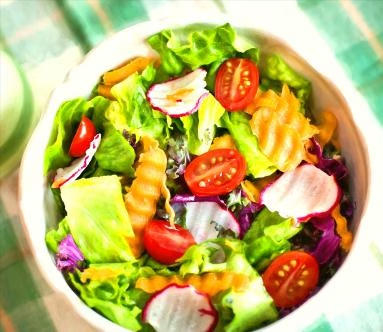Purchased fruits, vegetables, meat, and other ingredients can sometimes lose their freshness and moisture retention due to excessive storage, resulting in a loss of flavor and texture. Is there any way to restore ingredients that have slightly lost their freshness to a fresher state when cooking?
Tips for Restoring Freshness
Ingredients that have been refrigerated for a long time tend to become soft and stale. If they’re already spoiled, be sure to discard them. However, if they’ve only slightly lost their freshness, a simple trick can restore them.
Soak in 45°C Water to Restore Ingredients and Prevent Spoilage
Use warm water to prevent polyphenol oxidation. Inhibit oxidation and activate cells.
Polyphenol oxidation causes “browning,” the browning of apples when cut. Soaking fruits and vegetables in lukewarm water can inactivate the enzymes that cause polyphenol oxidation.
In addition, heat exposure increases the production of heat shock proteins, a protective mechanism in fruits and vegetables. Therefore, this little trick not only protects ingredients from oxidation and replenishes lost water from cells, but also keeps them vibrant and fresher for longer.
0°C Ice Water Revitalizes Fruits and Vegetables
Utilizing the Cold Shock Principle of Icing
Icing in ice water replenishes water and also has a cell-tightening effect.
Fruits and vegetables continue to respire even after harvest. In other words, they continuously consume stored energy and age. Rapidly chilling them in ice water can reduce their vital functions, instantly reducing their respiration rate and inhibiting aging.
Also, soaking fruits and vegetables in ice water for 20-30 minutes replenishes lost water from cells, restoring their crisp texture and vitality. Utilizing the cold shock principle can extend shelf life.
Vinegar + Sugar Water
Restore Plump and Elasticity
Utilize this dual effect to restore the plumpness and elasticity of ingredients.
Whether it’s vegetables or meat, fresh ingredients become dry and damaged by oxidation when exposed to air. Sugar helps vegetable cells and meat proteins absorb water, restoring their crispness and firmness. Furthermore, vinegar’s antiseptic properties inhibit bacterial growth and spoilage, helping to revitalize ingredients and extend their lifespan.
Revitalize Leafy Vegetables That Have Lost Their Freshness
0°C Ice Water Method for Leafy Vegetables
Revitalize Vitality
Before
Inhibit Respiration and Stop Aging
Leafy vegetables have large leaf areas, and constant respiration causes them to lose water and lose their freshness. Soaking them in ice water with ice cubes can inhibit aging and restore their crispness.
After
Restore Crispness and Vitality
Cooking Tips
Using the Cold Shock Principle to Revitalize Vegetable Leaves
Leafy vegetables like spinach, komatsuna, lettuce, and cabbage are best suited for the ice water method, which can restore a crisp texture to limp, wilted leaves.
Score the base of the spinach, remove the core of the cabbage and lettuce, and soak each leaf in 0°C ice water.
The effects can be seen in as little as a few minutes, but soaking for 20 to 30 minutes is generally recommended. Not only will the appearance improve, but the shelf life will also be extended. If you’re concerned about vitamin C loss, soaking for just 5 minutes will suffice.
WHY?
Shelf life extended by 2 times
Vegetable damage stems from the physiological mechanism of continued respiration after harvest. The ethylene gas produced by respiration helps ripen vegetables, but it also causes aging in leafy vegetables. Soaking vegetables in ice water induces cold shock, which causes a sudden drop in respiration rate, preventing energy consumption and inhibiting oxidation.
Avocados subjected to a 30-minute cold shock experience a delay of three days in reaching peak respiration, thus extending their shelf life.


Leave a Reply